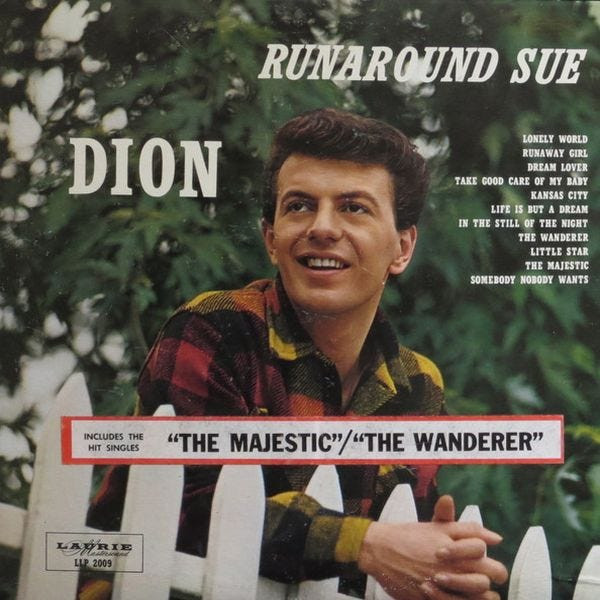Dion DiMucci, known mononymously as Dion, cemented his solo stardom with the release of “Runaround Sue” in September 1961. This wasn’t just another single; it was his first chart-topping hit, soaring to number one and etching itself into the annals of early 1960s rock and roll. Coming after a period where his singles charted lower and lower following the success of ‘Lonely Teenager’, “Runaround Sue” was a vital injection of energy, re-establishing Dion as a major force in the music scene. The song, featured on the album of the same name, perfectly encapsulated Dion’s evolving sound, a compelling blend of rock and roll dynamism with the smooth vocal harmonies of doo-wop, setting the stage for a string of further hits and solidifying his place in music history. This article delves into the magic of “Runaround Sue”, exploring the elements that contributed to its success and why it continues to resonate decades later.
“Runaround Sue” wasn’t solely a product of Dion’s individual artistry; it was a collaborative effort born from his partnership with Ernie Maresca. Co-written by the pair, the song was unleashed upon the listening public in September of 1961 and rapidly ascended the charts, claiming the coveted number one spot. This triumph wasn’t just a personal victory for Dion, it also served as the namesake for his album, “Runaround Sue,” further emphasizing the single’s significance. The album itself became a vehicle to showcase not only the hit track but also a collection of songs that mirrored Dion’s stylistic versatility.
 Dion Runaround Sue album cover. This image is the album cover for Dion's "Runaround Sue" album, featuring a black and white photo of Dion in a suit against a plain background. The album title "Runaround Sue" is prominently displayed above his head in stylized text. This album features the hit song "Runaround Sue" and solidified Dion's place in early 1960s rock and roll.
Dion Runaround Sue album cover. This image is the album cover for Dion's "Runaround Sue" album, featuring a black and white photo of Dion in a suit against a plain background. The album title "Runaround Sue" is prominently displayed above his head in stylized text. This album features the hit song "Runaround Sue" and solidified Dion's place in early 1960s rock and roll.
While Dion’s charismatic lead vocals are undeniably central to “Runaround Sue”‘s appeal, a significant component of its enduring charm lies in the contributions of The Del-Satins. This doo-wop group, though relatively obscure in their own right, became an integral part of Dion’s signature sound, providing backing vocals for many of his hit singles. In “Runaround Sue,” their presence is particularly pronounced. The unforgettable “hep-hep bum-da-hey-di-hey-di hep-hep” refrain, delivered by The Del-Satins, is arguably the most instantly recognizable element of the song. Remarkably, this vocal hook manages to evoke a dual sense of joy and melancholy simultaneously, a testament to the nuanced performance by the group. Dion himself mirrors this emotional duality in his wordless vocalizations, weaving in and out of The Del-Satins’ harmonies, creating a sonic texture that oscillates between upbeat energy and underlying wistfulness.
Musically, “Runaround Sue” occupies an intriguing space, straddling the energetic boundaries of rock and roll and the harmonic richness of doo-wop. Dion, while not aiming to revive the rawest forms of rock and roll that were waning in popularity by 1961, was equally determined to avoid being categorized as just another teen idol. “Runaround Sue” and its album represented this artistic tightrope walk. The rhythmic drive of the song owes a debt to rock and roll, providing a danceable energy that was irresistible to teenagers. Simultaneously, the vocal arrangements, heavily influenced by doo-wop traditions, added layers of harmony and a polished sheen that broadened its appeal. Adding further to the song’s sonic tapestry is the saxophone solo by Buddy Lucas. Lucas’s playing isn’t just a standard instrumental break; it’s an extension of the song’s emotional core, echoing the ecstatic yet slightly frantic energy present in Dion’s lead vocals and the backing harmonies, amplifying the overall dynamism of the track.
The lyrics of “Runaround Sue” present a narrative that, on the surface, appears to be a straightforward cautionary tale about a woman’s infidelity. However, a closer examination, particularly within the social context of 1961, reveals a more complex picture. From a modern perspective, the lyrics could be interpreted as overtly male-chauvinistic, with the male protagonist seemingly passing judgment on Sue’s freedom and choices. Lines about her running “around with every single guy in town” certainly lend themselves to this reading. Yet, viewed through a 1961 lens, and considering the song’s undeniable popularity with female audiences, another interpretation emerges. “Runaround Sue” can be seen as a song that, perhaps unintentionally, celebrates a woman’s liberation, albeit through the eyes of a jilted ex-lover. Sue, in her “runaround” nature, becomes the empowered figure, defying societal expectations and male possessiveness, while the narrator assumes the role of the “underdog.” This subversive element might have contributed to the song’s appeal, particularly for young women in the pre-Beatles era, who were beginning to embrace notions of greater personal freedom.
Within the album “Runaround Sue,” another significant hit emerged: “The Wanderer.” While both songs became signature tunes for Dion, they offer contrasting perspectives and musical styles. “Runaround Sue” is arguably the more melodically intricate of the two, with The Del-Satins playing a more prominent and defining role in its sound. “The Wanderer,” while equally successful, possesses a different kind of swagger and rhythmic drive. Where “Runaround Sue” is characterized by its infectious “hep-hep” harmonies and saxophone-driven exuberance, “The Wanderer” leans into a more assertive, almost defiant persona. Despite their differences, both tracks showcased Dion’s ability to navigate diverse sonic landscapes within the broader pop-rock framework of the early 1960s, contributing significantly to the album’s overall impact and commercial success.
The enduring appeal of “Runaround Sue” is multifaceted. Its infectious melody, anchored by the unforgettable vocal hook of The Del-Satins, ensures its catchiness and memorability. The lyrical content, open to varying interpretations, touches upon themes of love, betrayal, and freedom, resonating with listeners across generations, even if those themes are viewed through different lenses over time. Furthermore, the song embodies a nostalgic charm, transporting listeners back to the early 1960s, a pivotal era in music history where doo-wop was transitioning into the burgeoning sounds of rock and roll. “Runaround Sue” stands as a testament to Dion’s artistry, capturing a moment in time while retaining a timeless quality that continues to make it a beloved classic. Its place in Dion’s discography is undeniable; it is the song that catapulted him to the top, becoming synonymous with his name and a defining track of the early 60s pop scene. Even today, “Runaround Sue” remains instantly recognizable, a testament to its lasting impact and the magic it captured upon its release over six decades ago.

